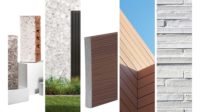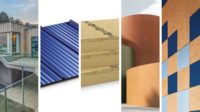When your neighbors include the Menil Collection, Rothko Chapel, and the Houston Center for Photography, the last thing you want is a nondescript office building—especially if you’re an architecture firm. Such was the concern when Dillon Kyle Architects (DKA) set out to build its new home in the Houston neighborhood of Montrose. To stand out, the firm explored cladding materials that it could manipulate with an eye-catching design. Glass and even papier-mâché were among some of the early contenders before the firm decided to use Accoya, a modified timber, selected for its dimensional stability, resistance to rot, and easily customizable surface.
The architects devised a three-story building with a cantilevered portion that shades the property’s parking lot and an informal gathering space. Then they applied approximately 12,000 square feet of the modified timber as a rainscreen attached to galvanized steel sheets offset from the structure. Accoya wraps the entire building, including the soffit and column of the cantilever, with the exception of apertures for windows and doors. The skin’s CNC-milled leaf pattern—developed in-house by the firm over the course of one year—starts out dense at the top of the building and gradates to nonrouted panels at the bottom, with each 8 foot-by-8 inch board measuring 11/16 inches thick.
“The pattern is a nod to the oak trees that are common to Houston, especially in the area around our building,” says Peter Klein, an associate principal at DKA. The beauty of this product—and another reason the architects chose it—is that over time, as different boards are exposed to varying amounts of sunlight and rain, it will develop a gray patina in an uneven, organic way, which will complement its leaf-patterned finish.








Post a comment to this article
Report Abusive Comment